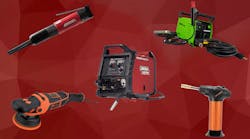After the recent harsh winter weather, many truck owners will notice wear and tear on their vehicles. One area that may be particularly hard hit from the elements is the truck bed. Repairing or replacing a damaged truck bed can be an expensive proposition. However, by painting the bed liner, truck owners will give it a fresh look and extend its life by making the truck bed resistant to rust and scratches.
Truck bed liner paint may come in a gallon can or in aerosol form. Leading brands like PlastiKote also offer a truck bed liner kit that includes a gallon of truck bed liner paint and all the necessary sundries like a roller, brush and paint tray.
Prep before the painting
Before getting started, it is very important to thoroughly prepare the truck bed. For best results, the truck bed should first be pressure washed, rinsed and dried thoroughly. Make sure to clean all contaminated surfaces with an oil and grease remover. These types of kits only work over the original factory finish or an aerosol version of truck bed liner, otherwise users might experience wrinkles or lifting in their coating.
After the bed is completely clean and dry, mask off all surrounding areas to protect from paint splatter or overspray, using a quality, automotive-grade masking tape and paper. Sand all areas to be painted with the scuff pad or sandpaper, making sure to sand or scuff only up to the masking-tape line. Completely remove any gloss from surfaces to be coated.
If there are rust spots, sand those areas until smooth and then prime with a sandable primer. Allow the primer to dry for at least two hours before sanding again. Then, thoroughly clean the truck bed to remove all sanding residue.
The painting process
It is very important to only paint outdoors or in a well-ventilated area when the air and the truck bed temperatures are between 60 and 90 degrees F and the humidity is below 60 percent. If you are using the gallon can of paint, first remove the lid and stir the paint for two minutes to ensure that all rubber granules on the bottom of the can are mixed in and then pour a small amount of coating into the paint tray.
Start by painting the corners, under the bed rails, and other difficult-to-reach areas first with the paint brush. Then using the roller, apply one light coat to the front and side-vertical surfaces of the truck bed using long, overlapping strokes for best results. Allow at least 20 minutes dry time before applying an additional full wet coat. Aerosol bed liner paint is a good option for corners, hard-to-reach places and to have on hand for small touch ups.
When painting the truck bed floor, make sure the tailgate is down and apply a light coat from inside the truck bed, starting at the front and work your way to the back. Allow at least 20 minutes between coats, applying an additional full wet coat to the truck bed floor while standing outside the truck bed. Apply additional coats for desired appearance or thickness. While still wet, any excess paint can be wiped away with soap and water. Truck bed liner paint cannot be removed after it dries. Allow at least 24 hours dry time before using the truck bed.
Information provided by: Plastikote

